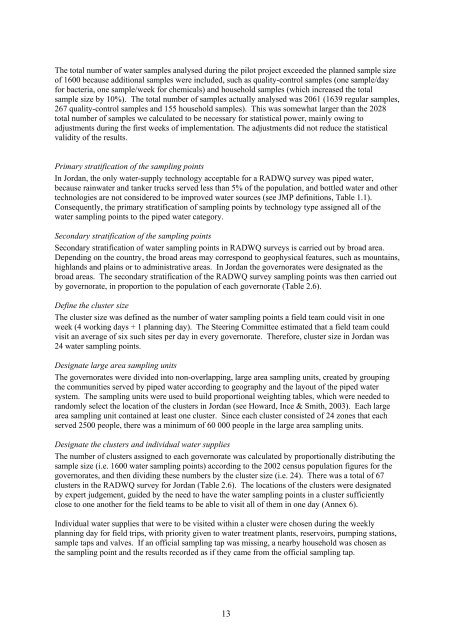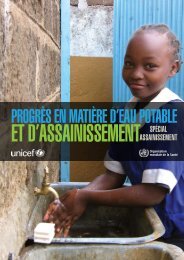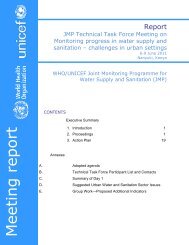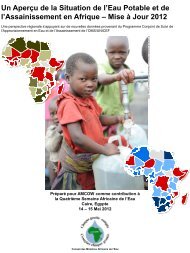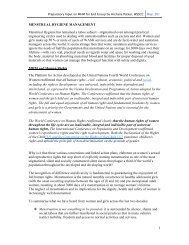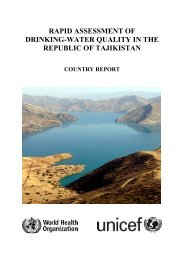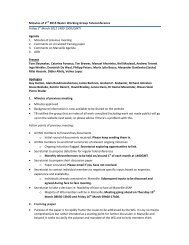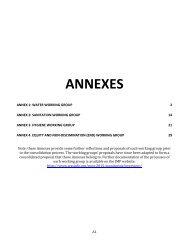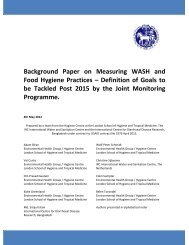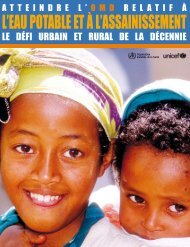Rapid assessment of drinking-water quality in the - WHO/UNICEF ...
Rapid assessment of drinking-water quality in the - WHO/UNICEF ...
Rapid assessment of drinking-water quality in the - WHO/UNICEF ...
Create successful ePaper yourself
Turn your PDF publications into a flip-book with our unique Google optimized e-Paper software.
The total number <strong>of</strong> <strong>water</strong> samples analysed dur<strong>in</strong>g <strong>the</strong> pilot project exceeded <strong>the</strong> planned sample size<br />
<strong>of</strong> 1600 because additional samples were <strong>in</strong>cluded, such as <strong>quality</strong>-control samples (one sample/day<br />
for bacteria, one sample/week for chemicals) and household samples (which <strong>in</strong>creased <strong>the</strong> total<br />
sample size by 10%). The total number <strong>of</strong> samples actually analysed was 2061 (1639 regular samples,<br />
267 <strong>quality</strong>-control samples and 155 household samples). This was somewhat larger than <strong>the</strong> 2028<br />
total number <strong>of</strong> samples we calculated to be necessary for statistical power, ma<strong>in</strong>ly ow<strong>in</strong>g to<br />
adjustments dur<strong>in</strong>g <strong>the</strong> first weeks <strong>of</strong> implementation. The adjustments did not reduce <strong>the</strong> statistical<br />
validity <strong>of</strong> <strong>the</strong> results.<br />
Primary stratification <strong>of</strong> <strong>the</strong> sampl<strong>in</strong>g po<strong>in</strong>ts<br />
In Jordan, <strong>the</strong> only <strong>water</strong>-supply technology acceptable for a RADWQ survey was piped <strong>water</strong>,<br />
because ra<strong>in</strong><strong>water</strong> and tanker trucks served less than 5% <strong>of</strong> <strong>the</strong> population, and bottled <strong>water</strong> and o<strong>the</strong>r<br />
technologies are not considered to be improved <strong>water</strong> sources (see JMP def<strong>in</strong>itions, Table 1.1).<br />
Consequently, <strong>the</strong> primary stratification <strong>of</strong> sampl<strong>in</strong>g po<strong>in</strong>ts by technology type assigned all <strong>of</strong> <strong>the</strong><br />
<strong>water</strong> sampl<strong>in</strong>g po<strong>in</strong>ts to <strong>the</strong> piped <strong>water</strong> category.<br />
Secondary stratification <strong>of</strong> <strong>the</strong> sampl<strong>in</strong>g po<strong>in</strong>ts<br />
Secondary stratification <strong>of</strong> <strong>water</strong> sampl<strong>in</strong>g po<strong>in</strong>ts <strong>in</strong> RADWQ surveys is carried out by broad area.<br />
Depend<strong>in</strong>g on <strong>the</strong> country, <strong>the</strong> broad areas may correspond to geophysical features, such as mounta<strong>in</strong>s,<br />
highlands and pla<strong>in</strong>s or to adm<strong>in</strong>istrative areas. In Jordan <strong>the</strong> governorates were designated as <strong>the</strong><br />
broad areas. The secondary stratification <strong>of</strong> <strong>the</strong> RADWQ survey sampl<strong>in</strong>g po<strong>in</strong>ts was <strong>the</strong>n carried out<br />
by governorate, <strong>in</strong> proportion to <strong>the</strong> population <strong>of</strong> each governorate (Table 2.6).<br />
Def<strong>in</strong>e <strong>the</strong> cluster size<br />
The cluster size was def<strong>in</strong>ed as <strong>the</strong> number <strong>of</strong> <strong>water</strong> sampl<strong>in</strong>g po<strong>in</strong>ts a field team could visit <strong>in</strong> one<br />
week (4 work<strong>in</strong>g days + 1 plann<strong>in</strong>g day). The Steer<strong>in</strong>g Committee estimated that a field team could<br />
visit an average <strong>of</strong> six such sites per day <strong>in</strong> every governorate. Therefore, cluster size <strong>in</strong> Jordan was<br />
24 <strong>water</strong> sampl<strong>in</strong>g po<strong>in</strong>ts.<br />
Designate large area sampl<strong>in</strong>g units<br />
The governorates were divided <strong>in</strong>to non-overlapp<strong>in</strong>g, large area sampl<strong>in</strong>g units, created by group<strong>in</strong>g<br />
<strong>the</strong> communities served by piped <strong>water</strong> accord<strong>in</strong>g to geography and <strong>the</strong> layout <strong>of</strong> <strong>the</strong> piped <strong>water</strong><br />
system. The sampl<strong>in</strong>g units were used to build proportional weight<strong>in</strong>g tables, which were needed to<br />
randomly select <strong>the</strong> location <strong>of</strong> <strong>the</strong> clusters <strong>in</strong> Jordan (see Howard, Ince & Smith, 2003). Each large<br />
area sampl<strong>in</strong>g unit conta<strong>in</strong>ed at least one cluster. S<strong>in</strong>ce each cluster consisted <strong>of</strong> 24 zones that each<br />
served 2500 people, <strong>the</strong>re was a m<strong>in</strong>imum <strong>of</strong> 60 000 people <strong>in</strong> <strong>the</strong> large area sampl<strong>in</strong>g units.<br />
Designate <strong>the</strong> clusters and <strong>in</strong>dividual <strong>water</strong> supplies<br />
The number <strong>of</strong> clusters assigned to each governorate was calculated by proportionally distribut<strong>in</strong>g <strong>the</strong><br />
sample size (i.e. 1600 <strong>water</strong> sampl<strong>in</strong>g po<strong>in</strong>ts) accord<strong>in</strong>g to <strong>the</strong> 2002 census population figures for <strong>the</strong><br />
governorates, and <strong>the</strong>n divid<strong>in</strong>g <strong>the</strong>se numbers by <strong>the</strong> cluster size (i.e. 24). There was a total <strong>of</strong> 67<br />
clusters <strong>in</strong> <strong>the</strong> RADWQ survey for Jordan (Table 2.6). The locations <strong>of</strong> <strong>the</strong> clusters were designated<br />
by expert judgement, guided by <strong>the</strong> need to have <strong>the</strong> <strong>water</strong> sampl<strong>in</strong>g po<strong>in</strong>ts <strong>in</strong> a cluster sufficiently<br />
close to one ano<strong>the</strong>r for <strong>the</strong> field teams to be able to visit all <strong>of</strong> <strong>the</strong>m <strong>in</strong> one day (Annex 6).<br />
Individual <strong>water</strong> supplies that were to be visited with<strong>in</strong> a cluster were chosen dur<strong>in</strong>g <strong>the</strong> weekly<br />
plann<strong>in</strong>g day for field trips, with priority given to <strong>water</strong> treatment plants, reservoirs, pump<strong>in</strong>g stations,<br />
sample taps and valves. If an <strong>of</strong>ficial sampl<strong>in</strong>g tap was miss<strong>in</strong>g, a nearby household was chosen as<br />
<strong>the</strong> sampl<strong>in</strong>g po<strong>in</strong>t and <strong>the</strong> results recorded as if <strong>the</strong>y came from <strong>the</strong> <strong>of</strong>ficial sampl<strong>in</strong>g tap.<br />
13


